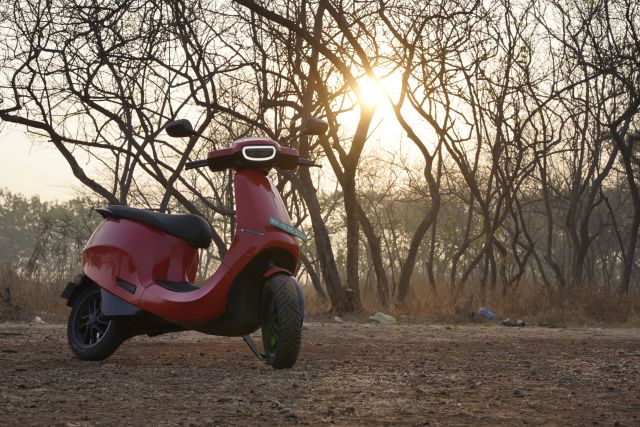Tethering your smartphone and playing music was not enough for the blokes at Ola, patented AI model taking inputs from the frequency, amplitude and volume to control eight lights on the scooter to make a party spot on the go kind of did it for them. The new MoveOS 3 came with a bevy of improvements and new features and they work quite well, more on that further down the story.

The feature list runs as long as the scooter’s claimed range, and the rider can access all of it via a seven-inch touchscreen that relays necessary information, such as the speed, battery percentage, and odo to name a few. The MoveOS 3 claims that the touch response is now 28 per cent better than the previous update and I would second that. The dash can be changed to your liking, there are three attractive layouts to choose from – Eclipse, Bolt and Vintage.
While the readouts for all three remain the same, the dials and design change accordingly. The rider can also toggle with the artificial engine sound the scooter makes to fill in the InternaI Combustion Engine (ICE) void. The scooter also has a multi-user operating system that can be personalised, settings and preferences are securely encrypted and in sync with one account registered to the rider. The dash can also be used to relay important documents such as the driver’s license, insurance, and registration certificate. There is a proximity unlock feature that enables the rider to unlock the scooter by just walking towards it or by just pushing the start button and bypassing the pin code protocol, works just fine by the way. Ola S1 Pro houses a 4.0 kWh battery that powers an 8.5 kW motor that relays about 11.6 hp of power to the rear wheels via a belt drive. There are four different ride modes on offer – Eco, Normal, Sport and Hyper. Each mode provides a different experience, the Hyper mode is the most engaging of all, it shoots you silently in a cinch. The throttle response is acute and the riding experience is much more engaging. There are three regen modes on offer – Low, Default and High. High is best suited for bumper-to-bumper traffic and low is apt for highway coasting, the Default mode can be used for everyday commutes around the city. I am happy to report that all the modes work without any lag or glitch.

A full charge from zero per cent takes seven hours on normal charging. The hyper charging feature works fine albeit with a few niggles. In our test, the scooter took 35 minutes of hyper charging to climb from 57 to 70 per cent of charge. While it did that, the time shown for achieving 70 per cent kept extending on the dash and the phone. And from there the time shown for a 100 per cent charge measured a good two and a half hours on the hyper charging station. But the motive of hyper charging is to get a decent set of numbers on the range quickly to get you home and that, it does pretty well.

A hill hold assist feature has also been added but it fluctuates while on an inclined surface. I consider this to be a teething issue with the new feature and with time this would be ironed out. Other features include hazard lights, vacation mode, party mode and overall improvements to existing features such as smoother touch response, better accuracy of prediction of time taken for charging, and improved odometer and trip meter to name a few. All features are a welcome addition and provide a better user experience for the rider.

Story: Sumesh Soman
Also read: Greaves Electric Mobility reveals ‘Arctic Tern’ Design





Leave a Reply